Massive campus built with health and well-being of its employees in mind — and the environment’s too.
MOUNTAIN VIEW, Calif. — Google’s stunning new headquarters officially opened this week and many are talking more about what happening on the outside of the building rather than the inside. The Bay View campus, spanning 42 acres adjacent to the NASA’s Ames Research Center in Silicon Valley, features “dragon skin” solar panels that will help the company fulfill its dedication to the environment.
Designed by architects Bjarke Ingels Group (BIG) and Heatherwick Studio, as well as Google’s design and engineering teams, the HQ totals 1.1 million square feet. It includes 20 acres of open space, two office buildings, an 1,000-person event center, and 240 short-term employee accommodation units.
Construction broke ground in 2017, and has this month officially opened to what the tech firm calls “Googlers.”
“This is the first time we designed and developed one of our major campuses, which allowed us to rethink the very idea of an office and what’s possible for the building industry. The result is a set of buildings that show what’s possible in human-centered and sustainable workplace design,” the company explains in a statement.
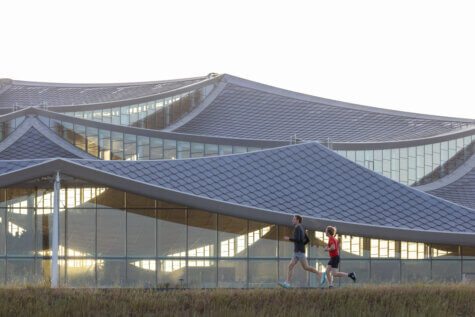
To help deliver on its commitment to operate every hour of every day on carbon-free energy by 2030, the “first-of-its-kind dragonscale solar skin”, as well as nearby wind farms, will power Bay View on carbon-free energy 90% of the time.
The dragonscale skin is made up of 90,000 silver solar panels with the capacity to generate nearly 7 megawatts of energy.
“The dragonscale solar roof that will adorn these buildings is the result of years of product development, collaboration with a handful of partners, and examining prototypes from manufacturers all over Europe,” explains Asim Tahir, Google District & Renewable Energy Lead. “The prismatic nature of the glass ‘trapped’ light that would normally escape from traditional flat solar panels and reduced reflective glare that can be a problem for drivers and pilots. That same texture that provides all that function, also gives the overlapping panels a unique sparkle that earned it its name ‘dragonscale’.”
Elsewhere, an integrated geothermal pile system – the largest in North America – is estimated to reduce carbon emissions by roughly 50% and will help both heat and cool the campus. The massive geoexchange field is integrated into the structural system, reducing the amount of water typically used for cooling by 90%, equal to five million gallons of water annually.
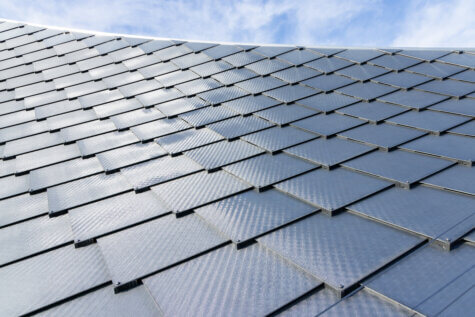
Google says the interior of the buildings reemphasise their vision for the future of work. It’s designed in response to its understanding of why Google’s employees come to the office, what they need from their teammates, and what they need from the company.
For those coming into the office, it was designed to balance Googlers’ desire to come together as teams with the need for an environment that enables deep-focus work. Team spaces are on the upper level and gathering spaces are below, separating focus and collaborative areas while still providing easy access to both.
The campus incorporates biophilic design principles, including greenery, natural daylight and views outside from every desk to improve the health and wellbeing of those inside the building. Clerestory windows modulate direct light onto desks with automated window shades that open and close over the course of the day.
The ventilation system uses 100% outside air. This means air flows one way, so there is no recycled air, which is much healthier for occupants.
To remove toxins and create the healthiest environment possible, the project team vetted thousands of building products and materials — everything from carpet tiles, paints, piping, plywood and furniture were evaluated using the Living Building Challenge (LBC) Red List as a framework.
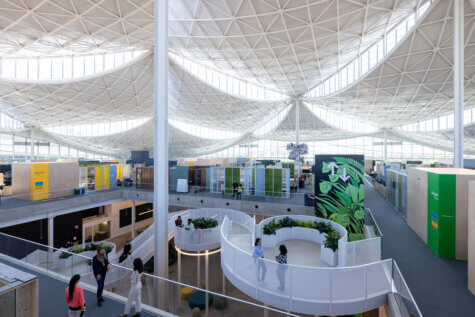
In an effort to deliver on its commitment to replenish 120% of the water it consumes by 2030, the site is net water-positive with all non-potable water demands being met using the recycled water it generates on site. A series of above-ground ponds gather rainwater, combined with a building wastewater treatment system, together serve as a water source for cooling towers, flushing toilets, and landscape irrigation.
The campus includes 7.3 acres of high-value natural areas – including wet meadows, woodlands, and marsh – that contribute to Google’s broader efforts to reestablish missing essential habitat in the Bay Area.
Sustainability is core to the Bay View campus and the site is expected to achieve a LEED-NC v4 Platinum certification and become the largest facility ever to attain the International Living Future Institute (ILFI) LBC Water Petal Certification.
Local residents can also benefit from the opening of the Bay View campus, including public access to expanded trails with panoramic views of the Bay, improved bike connections to Stevens Creek and Bay trails, and expanded car lanes and new bike lanes with the widening of R.T. Jones Road.
Google has not disclosed the financial cost of the campus.
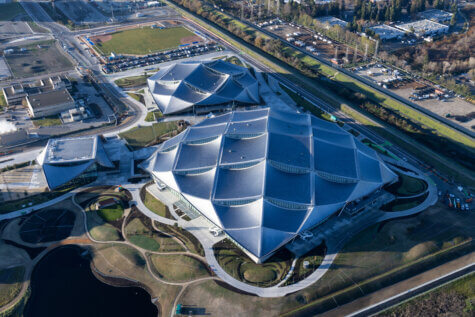
Report by South West News Service writer Dean Murray.
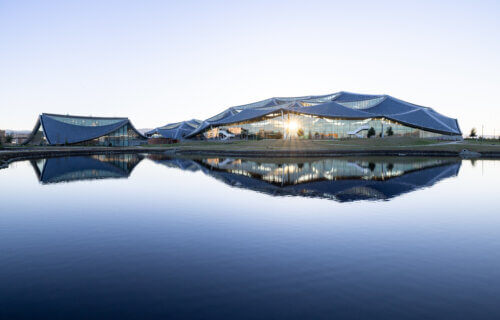
you ALWAYS leave out the most important information…..COST BREAKDOWN……how much is the solar system???? how much is the cost of the complete project??? PLEASE PROVIDE THIS INFORMATION…..